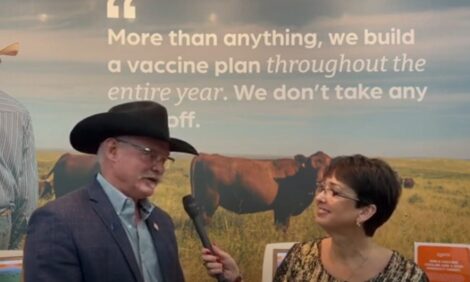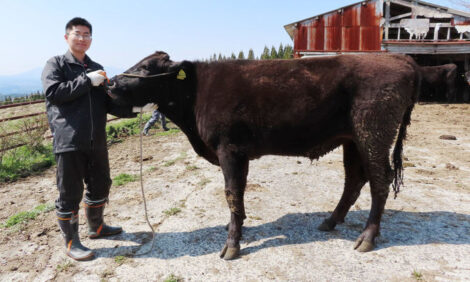



Weekly global protein digest: Japan halts some Brazilian poultry imports, USDA investing in meat processing
Jim Wyckoff shared global protein market newsRecent decline in venture capital funding for plant-based meat start-ups
That’s according to data from PitchBook, attracted $75.2 million in funding in the first quarter, across 22 deals, significantly down from $703 million gained during the same period the past year. This marks the lowest level of funding since 2018. Reasons for the downturn include a weaker economic outlook and rising interest rates, which are stifling enthusiasm for the industry. This decline also follows a marked drop last year when funding support from venture capital, a major source of financing for start-ups, fell to $1.5 billion — half of what it was in 2021.
China's state planning agency issues warning regarding declining hog prices
The agency says hog prices have now fallen into a critical "warning zone.” In response, the agency has outlined plans for a second round of pork purchases for state reserves this year. According to a report by Reuters, the agency is also set to keep a close eye on hog prices, while continuing efforts to control both hog production capacity and prices. This approach is aimed at maintaining stability in a crucial sector of China's domestic economy.
Tyson plans to reintroduce certain antibiotics into chickens
The Wall Street Journal (WSJ) reports Tyson Foods is set to reintroduce certain antibiotics back into its chicken supply chain, resulting in the removal of the “no antibiotics ever” label from Tyson-branded products. This shift will involve drugs called ionophores, which are not considered crucial for human health and are used to control a poultry disease called coccidiosis. This change will apply to all fresh, frozen and ready-made products sold under the Tyson brand and will take effect by the end of the year, according to WSJ.
Slightly negative USDA Hogs and Pigs Report
USDA has estimated the U.S. hog herd up 0.1% from year-ago as of June 1, whereas traders expected a 0.7% decline. All categories except spring farrowings and summer/fall farrowing intentions came in higher than anticipated. That could weigh slightly on summer and fall/winter hog futures, though we doubt the selling will be too intense or sustained.
China’s sow herd declines
China’s sow herd declined 0.6% in May from the previous month to 42.58 million head, according to the country’s ag ministry. However, the sow herd was still 1.6% larger than May 2022. China’s hog slaughter in May jumped 11% from year-ago. China’s hog slaughter through the first five months of this year topped year-ago levels by 9.9%.
Study: Plans for controlling a US ASF outbreak did not halt its progress
A study by North Carolina State University suggests that the current U.S. control measures may not be sufficient to completely halt the progress of an outbreak of African swine fever (ASF) within 140 days. While the measures taken, such as limiting animal movement and depopulation, managed to reduce the ASF spread by nearly 80% in computer simulations, only 20% of the virtual models had the virus completely under control by the end of this period.
What results mean. These results, as pointed out by Gustavo Machado, an assistant professor of population health and pathobiology at the university, indicate that while containment of ASF is possible, it could take longer than initially projected. The university is currently revising its simulation model with updated data and parameters to explore possibilities of controlling the virus within various timeframes.
The initial simulation, which was funded by USDA and based on data from over 2,000 real-world farms and records of past diseases, showed that close contact between pigs accounted for 71.1% of theoretical ASF cases. Other causes included the indirect spread through contaminated transportation (14.4%), and local transmission factors (14.6%).
The study also emphasized the role of pre-outbreak testing and screening measures. Although the cost of testing every animal may be high, the U.S. should continue to enhance existing surveillance measures and train more personnel in sample collection and analysis. The study particularly advised stricter controls for high-risk farms where animals comingle extensively, which could help detect and manage outbreaks earlier.
USDA Secretary Vilsack to announce another tranche of spending on meat processing
Whenever Vilsack travels, millions of dollars are announced and that is the case today when he will announce that $115 million will be distributed across 17 states in the form of 15 awards to augment meat and poultry processing capacity. This announcement will be made in Des Moines, Iowa.
The National Institute of Food and Agriculture managed by USDA will also grant seven awards totaling $4.5 million to community and technical colleges for the training of meat processing workers. The industry has been facing labor supply issues.
The funding will be allocated as follows: the Meat and Poultry Processing Expansion Program will distribute five awards totaling $38 million to support smaller, independent processing firms. The Meat and Poultry Intermediary Lending Program will dispense ten awards cumulating in $77 million. The funding for the educational grants will be channeled through the Meat and Poultry Processing — Agricultural Workforce Training program.
Japan halts some Brazilian poultry imports
Japan suspended purchases of poultry from the Brazilian state of Espirito Santo after an outbreak of highly pathogenic avian influenza (HPAI) on a non-commercial farm. The Brazilian Association of Animal Protein said the decision “is not in line with the guidelines of the World Organization for Animal Health” and noted Japan doesn’t currently import poultry from Espirito Santo.
Weekly USDA dairy report
CME GROUP CASH MARKETS (6/30) BUTTER: Grade AA closed at $2.4400. The weekly average for Grade AA is $2.4160 (+0.0416). CHEESE: Barrels closed at $1.3450 and 40# blocks at $1.3350. The weekly average for barrels is $1.3835 (-0.1234) and blocks, $1.3335 (-0.0646). NONFAT DRY MILK: Grade A closed at $1.1175. The weekly average for Grade A is $1.1195 (-0.0255). DRY WHEY: Extra grade dry whey closed at $0.2400. The weekly average for dry whey is $0.2465 (-0.0204).
BUTTER HIGHLIGHTS: Cream volumes are available in all regions, and some contacts in the Central region note cream suppliers in the region are offering larger volumes ahead of the July 4th holiday. Butter makers are operating active schedules, as some continue running seven-day schedules. In the Central region, some butter makers say they did not anticipate running current busy schedules at this point of the year but cite strong cream availability as contributing to current butter production. Cream remains available for strong butter production in the West. Contacts in the West say Independence Day has contributed to retail demand picking up this week and anticipate increased food service demand next week. The impending holiday is also contributing to strong demand for butter in the East. Demand for butter is steady in the Central region, as some stakeholders report sales are seasonally increasing. Bulk butter overages range from 0 to 10.75 cents over market value.
CHEESE HIGHLIGHTS: Milk is available for cheesemaking throughout the country. Some contacts in the Northeast say milk is being discarded. In the Upper Midwest milk surpluses are keeping cheese flowing into Class III plants, and cheesemakers say next week’s holiday is contributing to spot volumes of milk moving as low as $11 under Class. Cheesemakers are running active production schedules in the Northeast and West. In the Northeast, cheese sales are steady to strong. Contacts in the West report steady food service sales, but softening retail demand. Some contacts in the region note frozen pizza demand is below 2022 levels and say this is negatively impacting mozzarella cheese sales. Demand for cheese is busy in the Midwest, and some contacts report turning away new orders as they are nearly oversold. Cheese inventories in the region are not currently long. Meanwhile, Northeast cheese inventories are ample. Contacts in the West say spot loads of cheese barrels and blocks are available for purchasing.
FLUID MILK: Across much of the United States, milk production is trending lower along seasonal declines. Summer heat is impacting cow comfort, along with drought in parts of the East that report moderate to severe conditions. An exception is the Pacific Northwest and mountain states, where unusually cool temperatures edge milk production higher. Meanwhile, Class I demand is steady in the East and West. Reports suggest bottling activity continues to slow in the Central region, as cheesemakers report spot milk prices as low as $11 under Class. Cream is generally available ahead of the holiday weekend. Ice cream production remains active. Cream multiples for all Classes are 1.28 – 1.37 in the East, 1.20 – 1.32 in the Midwest, and 1.05 – 1.29 in the West. Condensed skim is expected to be widely accessible as well over the holiday period.
DRY PRODUCTS: Low/medium heat nonfat dry milk prices are lower across the country. Markets are seeing light activity as buyers wait to purchase while expecting price declines. High heat nonfat dry milk prices declined in all regions the Central, East, and West. Inventories are adequate for the limited demand. Dry buttermilk prices moved lower at the top of the Central and East price range, and prices are steady to lower on the range and the mostly series in the West. Dry whole milk prices are lower at the top of the range, in a market with limited activity. Prices for dry whey are steady to lower in the Central region, while lower in the West and East regions. Supplies are plentiful on steady production. Whey protein concentrate 34% mostly series prices are lower on the bottom of the range. Demand is light. Prices for lactose are steady this week. Spot demand is limited. Acid and rennet casein prices are unchanged.
ORGANIC DAIRY MARKET NEWS: The Agricultural Marketing Service (AMS) recently reported April 2023 estimated fluid product sales. The U.S. sale of total organic milk products was 219 million pounds, down 8.8 percent from the previous year and down 1.4 percent year-to-date. Organic whole milk sales, 110 million pounds, were down 3.2 percent compared to a year earlier, but up 3.6 percent year-to-date. Reduced fat milk (2%) sales were 69 million pounds, down 12.8 percent from the previous year and down 5.4 percent year-to-date. Organic flavored whole milk sales, 1 million pounds, decreased 70.9 percent from the previous year, while declining 55.1 percent year-to-date. June’s 2023 retail survey of selected supermarkets in 30 U.S. cities identifies the prices of organic whole milk in the half gallon container. The retail prices ranged from $3.99 in multiple cities to $6.49 in Pittsburgh, PA. The June 2023 simple average price, $4.85, increased compared to $4.82 the previous month. The graph below shows the organic milk price in the half gallon package size for the U.S. cities surveyed. Leading up to the July 4th holiday period, retail grocers across the country increased their total retail organic dairy advertisements 3 percent over the previous retail survey ad percentage.
NATIONAL RETAIL REPORT: As July 4th nears retailers have been preparing for the holiday by increasing the number of dairy products advertised. Total conventional dairy ads increased by 13 percent in this week’s survey, while total organic dairy ads grew by 1 percent. Ice cream in 48-64-ounce containers was the most advertised conventional dairy product in this week’s survey, while appearing in 26 percent more ads than in week 25. This item had a weighted average advertised price of $3.88, which was down 3 cents from last week. Organic ice cream in 48-64-ounce containers appeared in this week’s survey after no ads were present last week, and had a weighted average advertised price of $7.99. This results in an organic premium of $4.11. Total advertisements for conventional cheese increased by 29 percent this week, while total organic ads grew by 21 percent. The most advertised conventional cheese item was sliced cheese in 6-8-ounce packages, after appearing in 8 percent more ads this week. Conventional yogurt ads declined by 32 percent this week, and organic yogurt ads fell by 68 percent.



